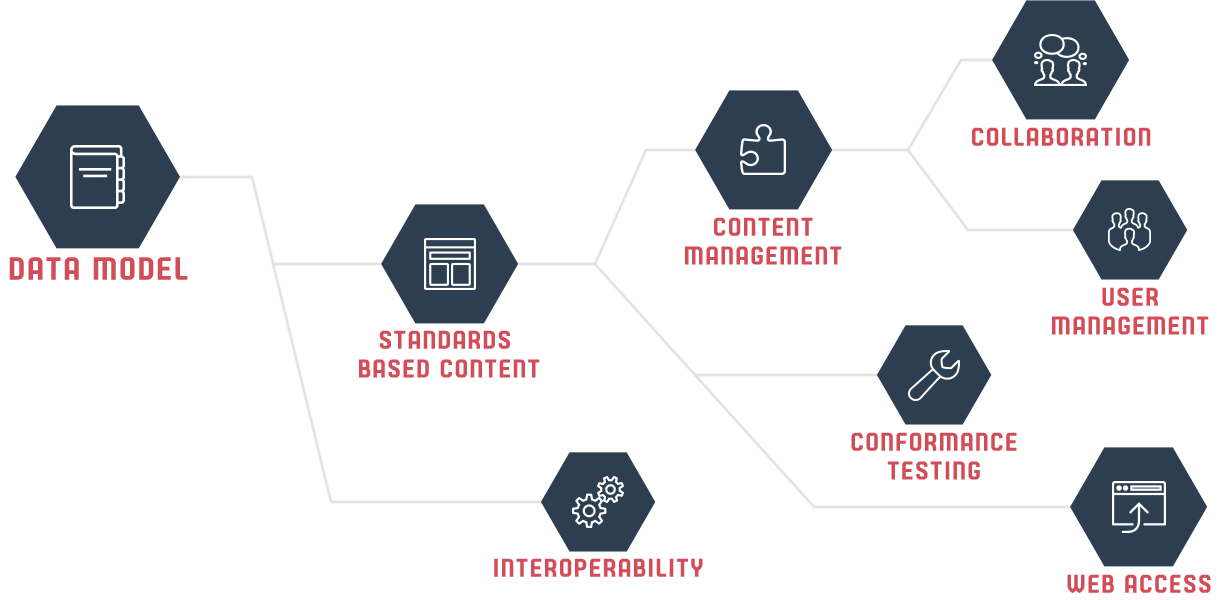Semantic MDR EE
intelligent metadata management through latest semantic web technologies

Semantic MDR EE is a web-based metadata management and data modelling tool to create and maintain common data models collaboratively either based on imported standard content models or from scratch.
Through its spreadsheet based user-friendly interfaces, it hides the implementation specific details and allows the modelers to focus on the data models to be managed.
Semantic MDR is a full implementation of the ISO/IEC 11179 (2nd edition) meta-model. There are two versions of the Semantic MDR. The Open Source Edition is maintained within GitHub while the Enterprise Edition is a commercial product.
The implementation of the Semantic MDR has started with the SALUS Project and the Open Source Edition was created. The research behind the C2-SENSE Project has led to the development of the Enterprise Edition of the Semantic MDR.
Semantic MDR EE's collaboration environment provides an auditable governance and user management platform where the content developers can submit their data models to experienced content administrators for approval. Meanwhile data ownership and versioning is also ensured.
Semantic MDR EE allows users to query and browse the data model repository, and create their data models based on existing data models and hence increase the reusability as well as reducing the data model redundancy.
Take a look at what Semantic MDR EE provides:
The main objective of Semantic MDR EE is to facilitate data interoperability between disparate applications.
- Generation and maintenance of data models collaboratively through a role-based process.
- Increasing the reuse of data models by allowing users to query and browse the data model repository through user friendly views.
- Implement/Customize existing standard content models according to requirements.
- Maintain code lists and associate them to data model elements (common data elements).
At the implementation level, Semantic MDR EE provides importers to obtain the data models of the existing standards and customize them according to the needs and furthermore, it provides exporters to generate implementation specific artifacts to guide implementers and give an initial starting point.
Collaboration environment of Semantic MDR EE provides an enhanced notification mechanism, where the interested parties are notified in case of a data model event (such as create, update, submit or change).
Based on ISO/IEC 11179 Metadata Registry (MDR) standard, Semantic MDR EE’s data modeling infrastructure enables to users to generate strongly-typed information models in terms of objects, object properties and object-to-object associations. These generated data models are presented to users through a browser-based spreadsheet user interface organized in a format aligned with their user role.
Furthermore, the role-based governance process proposed by UN/CEFACT’s Core Component Technical Specification (CCTS) is fully implemented in Semantic MDR EE. It gives content administrators full control over object approval processes supporting any combination of parallel and sequential submissions by content developers. Accompanying this highly flexible data modeling infrastructure, by fully complying with OASIS Genericode specification, Semantic MDR EE provides a terminology server, where the users are able to maintain their code lists (and mappings among them) and associate them to the coded elements in their data models.
Who uses Semantic MDR EE?
Enterprises to maintain their data models as organizational assets to facilitate data interoperability, and implement standards faster and more efficiently.
Standard Development Organizations (SDOs) to create and maintain their specifications.
Organizations (either public or private) who manages/conducts interoperability projects to customize the standards according to their needs.
Capabilities of Semantic MDR EE:
Full compliance to the ISO/IEC11179 meta-model
Web-based (HTML5 + Javascript), 7/24 accessible from any browser
Java based RESTful implementation, no dependency to any operating systems
Context based management of the Administered Items
Browsing through Object Classes and Data Elements
CRUD (Create-Update-Delete) operations for any ISO/IEC11179 construct (Administered Items, Objet Classes, Properties, Data Element Concepts, Data Elements, Conceptual Domains etc...)
Mappings between different Data Elements through Classification Schemes
Extraction Specifications to physical data models (i.e. XPath expressions for XML Schema based document/message models)
Keyword based search
OWL Ontology for the ISO/IEC 11179 meta-model
RDF based internal data models
Triple-store based persistence
Native SPARQL endpoint
IHE DEX Profile compliance
Data Element serialization – conforming to the ISO/IEC11179 ontology – indifferent RDF serialization formats (RDF/XML, Turtle, N-triples)
Enhanced user management with content administrator and content developer roles
Access control mechanism
- Resources are bound to the users as dictated by ISO/IEC 11179
- Project (Context) based access control
Collaborative development
- Multi-user
- Versioning
- Project (Context) Administrators for the data dictionary / content model development
- Approval mechanism by the administrators
Role-based, focused, user friendly GUIs
Hierarchical presentation of the elements in the data dictionary / content model
Advanced search
Terminology server integration
- CRUD on terms of the terminology systems and their mappings
- Value Domains can be bound to some value sets which are maintained under the terminology server
- Compliance to OASIS genericode: XML-based standard for representing value sets and term relations
Multilingual GUI
- English and Turkish
Schematron support
- GUIs for schematron rules
- Schematron use for the constraints between data elements
Exporter for the Contexts
- Support for XML Schema, Schematron, Value Set export





